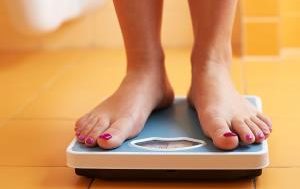
Counting calories is a good tool for weight loss and building muscle, but it’s not the best fit for everyone.
Getty Images
There’s some controversy about whether or not calorie-counting is a good way to get healthy or lose weight. Some experts argue that counting calories can lead to food restriction beyond what’s healthy and encourage disordered eating. Other experts say that counting calories is an efficient and effective approach to weight loss.
If one thing is for certain, it’s that there’s no “best” approach to health or weight loss. Just like some people thrive on HIIT training while others find fitness through running — and others don’t like structured exercise at all — some people will find success with calorie-counting and others will not.
This guide to counting calories covers how it can help with health goals, when it works and when it doesn’t, and exactly how to get started.
Counting calories for weight loss and weight gain
Weight management is simply a game of calories in and calories out. A calorie is a unit of measurement that describes how much energy a given food or drink has. The same unit of measurement is used to describe how much energy you exert in a day (calories burned).
To lose weight, you must burn more calories than you consume, and to gain weight, you must consume more calories than you burn. If you’re interested in changing your weight one way or the other, you’ll need to create a calorie deficit or a calorie surplus — and to make sure you stay in your desired surplus or deficit, you need to keep track of the calories you eat and burn. You can create the calorie balance you desire by counting the calories you eat and burn.
Say you want to lose 10 pounds over 10 weeks (one pound per week). One pound of body fat is roughly equal to 3,500 calories, though there is potential for variation among individuals depending on the density of body fat and how your body composition changes over time.
Based on the 3,500-calorie estimate, you need to create a calorie deficit of 3,500 calories each week to lose that one pound. You can do this in a few ways:
- Reduce your calorie consumption by 500 calories per day
- Increase or intensify exercise to burn 500 calories per day
- A mix of the two, e.g. reduce your calorie consumption by 250 calories per day and burn an additional 250 calories per day through exercise
The bottom line of all weight-loss programs is a change in your calorie balance through dietary habits and exercise, though that bottom line might be disguised by other tactics, like intermittent fasting or food group exclusions.

Calorie counting can help you make healthier food choices.
Getty Images
When calorie counting works and when it doesn’t
Calorie counting isn’t for everyone. Nor is any sort of food-tracking or logging, for that matter. Some people just want to eat food and enjoy it without worrying about caloric value. Some people don’t have the time or energy to count calories (that’s most of us, probably), and others have health goals that don’t involve counting calories.
Calorie counting works when:
- Your focus is strictly losing or gaining weight
- You want a simple, no-frills way to keep tabs on your diet
- You need to keep track for medical reasons
Calorie counting isn’t the best method if:
- You want to change your body composition (tracking macros is a better approach for body recomposition)
- You want or need to keep track of micronutrients, such as particular vitamins or minerals
- You have a history of disordered eating and feel the urge to drastically cut calories to an unhealthy level
- You’re not actually sure how many calories you need to eat
How to start counting calories the right way
The first thing you need to do is determine how many calories you need each day. Counting them does you no good if you’re eating too few or too many. The absolute best way to determine your daily calorie allowance is to work with a registered dietitian, physician or certified nutritionist who can take your weight, height, health history and goals into account for an ideal daily calorie number.
If seeing a pro isn’t on the table, however, you can use an online calorie calculator, like this one from Mayo Clinic, to find out. Most calorie calculators use the same formula, the Mifflin-St Jeor equation, which accounts for gender, height, weight, age and activity level. Like the disclaimer on Mayo Clinic’s calorie calculator says, other factors also influence your daily calorie needs. Pregnancy, illnesses and occupation contribute, too.
Once you have your number, you can start counting your calories. To create a deficit, eat fewer calories than your maintenance number, and to create a surplus, eat more. You can keep track in a pen-and-paper journal or use a calorie-counting app.

The See How You Eat food journal app focuses on taking photos, rather than logging words. This is a great approach to food journaling if you find yourself forgetting to write down the details.
See How You Eat/App Store
Logging packaged foods
Counting the calories in packaged foods is easy: Just look at the nutrition label and write down the calorie amount. Don’t forget about serving sizes, though — if you eat two servings, double the calorie count that’s on the label.
Logging fresh foods
Tracking fresh foods is a little harder than tracking packaged foods because there’s typically no label. But it’s easy to find calorie data online. You can search virtually any food on the FDA’s FoodCentral database to find complete nutrition info. Most food-tracking apps have massive databases of foods, too, so don’t let the lack of a nutrition label deter you from eating fresh foods.
Logging restaurant meals
Logging the calories in restaurant meals can be tricky if the restaurant isn’t a chain. In 2018, the FDA mandated that all restaurants with more than 20 locations must disclose calorie information for all menu items, so it’s easy enough if you’re eating at a regional or national chain restaurant. Local restaurants aren’t required to disclose calorie counts, but if you ask your server, there’s a good chance they can find out.

Don’t forget to log your coffee!
Getty Images
Logging beverages
Don’t forget to count the calories in the beverages you drink throughout the day. Unless you drink nothing but plain water and zero-calorie beverages (including black coffee and tea without sweeteners or milk), your drinks contribute to your daily calorie intake. Make sure to count the calories from the creamer in your coffee, sports drinks, alcohol, soda and juices.
Calories can’t tell you about the quality of your diet
While calories are useful for intentional weight loss or weight gain, they don’t tell you anything in the way of micronutrients. The quality of your diet is arguably just as important as the number of calories you eat each day: Where your calories come from makes a big difference in your overall health. A calorie is more than a simple unit of measurement when assessing how foods influence your overall health.
A 100-calorie serving of almonds affects your body much differently than 100 calories worth of a Twinkie, for instance. Almonds have fiber, protein, healthy fats, vitamins and minerals, whereas a Twinkie contains mostly sugar and saturated fat. A handful of almonds will give you sustained energy; a Twinkie will probably cause your blood sugar to spike and crash — and those are only the short-term effects.
Long-term, almonds offer health benefits like blood sugar control and lower cholesterol levels. Many of the ingredients in Twinkies — sugar, high fructose corn syrup and hydrogenated oils, to name a few — have been associated with increased risk of chronic diseases.

For the same number of calories in a candy bar, you can eat far more fruits and vegetables.
Getty Images
The great thing, though, is that filling your diet with fruits, vegetables, whole grains, lean protein and healthy fats should naturally curb your calorie intake. You’ll get full on fewer calories because nutritious foods tend to be less calorie-dense than sugary, fatty or processed foods.
If you’re interested in the pursuit of health, want to fend off chronic diseases, keep up your fitness and age healthfully, your best bet is to pay attention to both your calorie intake and the quality of the foods you eat.
The information contained in this article is for educational and informational purposes only and is not intended as health or medical advice. Always consult a physician or other qualified health provider regarding any questions you may have about a medical condition or health objectives.



